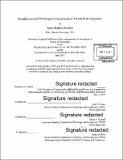Geophysical and petrological constraints on ocean plate dynamics
Author(s)
Sarafian, Emily Kathryn
DownloadFull printable version (17.23Mb)
Other Contributors
Woods Hole Oceanographic Institution.
Advisor
Rob L. Evans and Glenn A. Gaetani.
Terms of use
Metadata
Show full item recordAbstract
This thesis investigates the formation and subsequent motion of oceanic lithospheric plates through geophysical and petrological methods. Ocean crust and lithosphere forms at mid-ocean ridges as the underlying asthenosphere rises, melts, and flows away from the ridge axis. In Chapters 2 and 3, I present the results from partial melting experiments of mantle peridotite that were conducted in order to examine the mantle melting point, or solidus, beneath a mid-ocean ridge. Chapter 2 determines the peridotite solidus at a single pressure of 1.5 GPa and concludes that the oceanic mantle potential temperature must be -60 °C hotter than current estimates. Chapter 3 goes further to provide a more accurate parameterization of the anhydrous mantle solidus from experiments over a range of pressures. This chapter concludes that the range of potential temperatures of the mantle beneath mid-ocean ridges and plumes is smaller than currently estimated. Once formed, the oceanic plate moves atop the underlying asthenosphere away from the ridge axis. Chapter 4 uses seafloor magnetotelluric data to investigate the mechanism responsible for plate motion at the lithosphere-asthenosphere boundary. The resulting two dimensional conductivity model shows a simple layered structure. By applying petrological constraints, I conclude that the upper asthenosphere does not contain substantial melt, which suggests that either a thermal or hydration mechanism supports plate motion. Oceanic plate motion has dramatically changed the surface of the Earth over time, and evidence for ancient plate motion is obvious from detailed studies of the longer lived continental lithosphere. In Chapter 5, I investigate past plate motion by inverting magnetotelluric data collected over eastern Zambia. The conductivity model probes the Zambian lithosphere and reveals an ancient subduction zone previously suspected from surface studies. This chapter elucidates the complex lithospheric structure of eastern Zambia and the geometry of the tectonic elements in the region, which collided as a result of past oceanic plate motion. Combined, the chapters of this thesis provide critical constraints on ocean plate dynamics.
Description
Thesis: Ph. D., Joint Program in Oceanography/Applied Ocean Science and Engineering (Massachusetts Institute of Technology, Department of Earth, Atmospheric, and Planetary Sciences; and the Woods Hole Oceanographic Institution), 2017. Cataloged from PDF version of thesis. Includes bibliographical references.
Date issued
2017Department
Joint Program in Oceanography/Applied Ocean Science and Engineering; Woods Hole Oceanographic Institution; Massachusetts Institute of Technology. Department of Earth, Atmospheric, and Planetary SciencesPublisher
Massachusetts Institute of Technology
Keywords
Joint Program in Oceanography/Applied Ocean Science and Engineering., Earth, Atmospheric, and Planetary Sciences., Woods Hole Oceanographic Institution.